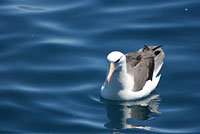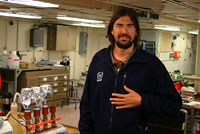

 | |||||||||||||||||||||
|
|
Journals 2008/2009Jeff Lawrence
December 18, 2008 All of these animals were photographed on the same day. How terrific Mother Nature is to allow me to enjoy her beauty off the Patagonian Shelf in the South Atlantic? On any given day you are likely to see something worthy of a photograph, whether it be marine animals, the azure blue water, or the amazing clouds that occur on a daily basis. The clouds interaction with the sun, always offer a changing vista that is pleasing to both the eye and soul. As we go further south we should encounter more marine mammals as they migrate south for feeding around Antarctica. This time of year in Antarctica a feeding frenzy occurs as an abundance of phytoplankton and krill are available for the marine life, some whom have traveled thousands of miles for this feast. Antarctica plays a vital role in the distribution of nutrients around the globe for many marine species. In the summer time it becomes alive beneath and above the oceans as many species arrive to feast on its bounty.
Ricardo Silva is on board the ship for Argentina's Fisheries Dept. Argentina has a huge interest in this expedition since the waters being studied are off its coastline. Ricardo is filtering samples from the CTD water brought on board. He is investigating phytoplankton diversity for differing methods of microscopy. Those would include light microscopy, fluorescents microscopy, and electronic microscopy. Developing these methods for identifying phytoplankton can tell scientist much about what is in the water around them. The reason the ship is in this area is because the Patagonian Shelf has the most prolific phytoplankton blooms in the World. You can count on these blooms appearing in great detail as seen in a previous journal entry from satellite photos during the month of December in this region.
Questions of the day:
|
||||||||||||||||||||




